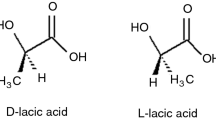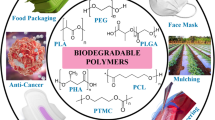Abstract
Ether group (E) diols [HO(CH2CH2O)xH, x = 2, 3, 4, 5, 6, and 8] and polyethylene glycol (PEG) [HO(CH2CH2O)xOH] were used as initiators in the ring-opening polymerization (ROP) of ε-caprolactone (CL) catalyzed by ammonium decamolybdate to synthesize the poly(ε-caprolactone) (PCL) macrodiols such as HOPCL–E–PCLOH and HOPCL–PEG–PCLOH, respectively. The effect of E or PEG on the crystallinity of the PCL segments (xPCL) in HOPCL–E–PCLOH homopolymer and HOPCL–PEG–PCLOH triblock copolymer was evidenced, respectively, where a weight percent of E or PEG was inversely proportional to the xPCL; this effect was explained due to that the ether segments are causing a partial disruption on the crystalline domain of PCL. A couple of species of poly(ester–ether–urethanes) (PEU) derived from HOPCL–E–PCLOH and HOPCL–PEG–PCLOH with 1,6-hexamethylene diisocyanate (HDI) were prepared, and these PEU showed an elastomeric behavior. Comparing two samples of PEU prepared from E (MW = 370 g/mol) (PEUE) and PEG (Mn = 408 g/mol) (PEUPEG), a parallel profile of their mechanical properties was seen. Eventually, HOPCL–E–PCLOH and HOPCL–PEG–PCLOH species showed similarities in terms of crystallinity and elastomeric behavior from their PEU derivatives. In addition, HOPCL–E–PCLOH and HOPCL–PEG–PCLOH and PEU samples were characterized by 1H NMR, FT-IR, GPC, DSC, and mechanical properties. Hence, homopolymers and triblock copolymers derived from PCL macrodiols with E or PEG segments, respectively, and their PEU had similarities in terms of chemical structure and physical properties








Similar content being viewed by others
References
Báez JE, Martínez-Rosales M, Martínez-Richa A (2003) Ring-opening polymerization of lactones catalyzed by decamolybdate anion. Polymer 44:6767–6772
Báez JE, Marcos-Fernández A, Lebrón-Aguilar R, Martínez-Richa A (2006) A novel route to α,ω-telechelic poly(ε-caprolactone) diols, precursors of biodegradable polyurethanes, using catalysis by decamolybdate anion. Polymer 47:8420–8429
Báez JE, Marcos-Fernández A, Galindo-Iranzo P (2011a) On the effect of alkyl end group in poly(ε-caprolactone) oligomers: preparation and characterization. Polym Plast Technol Eng 50:839–850
Báez JE, Ramírez-Hernández A, Marcos-Fernández A (2011b) The effect of trifluoroacetic anhydride on poly(ε-caprolactone) (PCL) oligomers. Int J Polym Anal Charact 16:377–389
Báez JE, Marcos-Fernández A, Martínez-Richa A, Galindo-Iranzo P (2017a) Poly(ε-caprolactone) diols (HOPCLOH) and their poly(ester-urethanes) (PEUs): the effect of linear aliphatic diols [HO–(CH2)m–OH] as initiators. Polym Plast Technol Eng 56:889–898
Báez JE, Zhao R, Shea KJ (2017b) Synthesis of poly(methylene-b-ε-caprolactone) and poly(ε-caprolactone) with linear alkyl end groups: synthesis, characterization, phase behavior, and compatibilization efficacy. Ind Eng Chem Res 56:10366–10383
Bai J, Wu N, Wang Y, Li Q, Wang X, Zhang L (2016) Triblock and pentablock copolymerizations of ε-caprolactone with l-lactide catalyzed by N-heterocyclic carbene. RSC Adv 6:108045–108050
Brzeska J, Morawska M, Sikorska W, Tercjak A, Kowalczuk M, Rutkowska M (2017) Degradability of cross-linked polyurethanes based on synthetic polyhydroxybutyrate and modified with polylactide. Chem Pap 71:2243–2251
Choi J, Kim IK, Kwak SY (2005) Synthesis and characterization of a series of star-branched poly(ε-caprolactone)s with the variation in arm numbers and lengths. Polymer 46:9725–9735
Colwell JM, Wentrup-Byrne E, George GA, Schué F (2015) A pragmatic calcium-based initiator for the synthesis of polycaprolactone copolymers. Polym Int 64:654–660
Crescenzi V, Manzini G, Calzolari G, Borri C (1972) Thermodynamics of fusion of poly-β-propiolactone and poly-ε-caprolactone. Comparative analysis of the melting of aliphatic polylactone and polyester chains. Eur Polym J 8:449–463
Erdagi SI, Doganci E, Uyanik C, Yilmaz F (2016) Heterobifunctional poly(ε-caprolactone): synthesis of α-cholesterol-ω-pyrene PCL via combination of ring-opening polymerization and “click” chemistry. React Funct Polym 99:49–58
Guo F, Guo D, Zhang W, Yan Q, Yang Y, Hong W, Yang G (2017) Preparation of curcumin-loaded PCL–PEG–PCL triblock copolymeric nanoparticles by a microchannel technology. Eur J Pharma Sci 99:327–328
Hlaváč D, Klushina D, Tokarský J (2018) Interaction of antitumoral drug erlotinid with biodegradable triblock copolymers: a molecular modeling study. Chem Pap 72:2023–2034
Li Y, Ma Q, Huang C, Liu G (2013) Crystallization of poly(ethylene glycol) in poly(methyl methacrylate) networks. Mater Sci (Medžiagotyra) 19(2):1320–1392
Lin C-Y, Hsu S-H (2015) Fabrication of biodegradable polyurethane microspheres by a facile and green process. J Biomed Mater Res Part B Appl Biomater 103B:878–887
Ma Z, Hong Y, Nelson DM, Pichamuthu JE, Leeson CE, Wagner WR (2011) Biodegradable polyurethane ureas with variable polyester or polycarbonate soft segments: effects of crystallinity, molecular weight, and composition on mechanical properties. Biomacromol 12:3265–3274
Martuscelli E, Silvestre C, Glsmondi C (1985) Morphology, crystallization and thermal behavior of Poly(ethylene oxide)/poly(vinyl acetate) blends. Die Makromolekulare Chemie 186(10):2161–2176
Meier MM, Kanis LA, de Lima JC, Pires ATN, Soldi V (2004) Poly(caprolactone triol) as plasticizer agent for cellulose acetate films: influence of the preparation procedure and plasticizer content on the physico-chemical properties. Polym Adv Technol 15:593–600
Pazarçeviren E, Erdemli Ö, Keskin D, Tezcaner A (2017) Clinoptilolite/PCL–PEG–PCL composite scaffolds for bone tissue engineering applications. J Biomater Appl 31(8):1148–1168
Ping P, Wang W, Chen X, Jing X (2005) Poly(ε-caprolactone) polyurethanes and its shape-memory property. Biomacromol 6:587–592
Scribanti A, Bortoluzzi M, Gatto M (2016) New heteroscorpionate lanthanide complexes for ring-opening polymerization of ε-caprolactone and rac-lactide. Chem Pap 70:53–60
Yao L-H, Shao S-X, Jiang L, Tang N, Wu J-C (2014) Ring-opening polymerization of ε-caprolactone catalyzed by Brønsted acids. Chem Pap 68:1381–1389
Yin G, Zhao D, Wang X, Ren Y, Zhang L, Wu X, Nie S, Li Q (2015) Bio-compatible poly(ester-urethane)s based on PEG–PCL–PLLA copolymer with tunable crystallization and biodegradation properties. RSC Adv 5:79070–79080
You JH, Choi S-W, Kim J-H, Kwak Y-T (2008) Synthesis and microphase separation of biodegradable poly(ε-caprolactone)-poly(ethylene glycol)-poly(ε-caprolactone) multiblock copolymer films. Macromol Res 16:609–613
Acknowledgements
José E. Báez would like to thank the “Consejo Nacional de Ciencia y Tecnología (CONACYT), Proyecto 284893”, “Dirección de Apoyo a la Investigación y al Posgrado (DAIP) at University of Guanajuato (UG), Proyecto CIIC 103/2018” and “Sistema Nacional de Investigadores (SNI)” in México for the financial support of the work. José E. Báez would also like to thank Ángel Marcos Fernández for believing in these ideas and providing financial support for the reagents through the project MAT2017-87204-R from the Ministry of Economy and Competitiveness (MINECO) of Spain. José E. Báez would like to thank Gema Reina Mendieta and Dr. Rebeca Yasmín Pérez Rodriguez for the acquisition of the NMR spectra and DSC instrument, respectively. Finally, José E. Báez would also like to thank Irene Caso and Sonoko Kawawada for her support.
Author information
Authors and Affiliations
Corresponding author
Additional information
Publisher’s Note
Springer Nature remains neutral with regard to jurisdictional claims in published maps and institutional affiliations.
Rights and permissions
About this article
Cite this article
Báez, J.E., Marcos-Fernández, Á. & Navarro, R. Similarities between homopolymers and triblock copolymers derived from poly(ε-caprolactone) (PCL) macrodiols (HOPCL–E–PCLOH and HOPCL–PEG–PCLOH) and their poly(ester-ether-urethanes): synthesis and characterization. Chem. Pap. 73, 1287–1299 (2019). https://doi.org/10.1007/s11696-019-00683-3
Received:
Accepted:
Published:
Issue Date:
DOI: https://doi.org/10.1007/s11696-019-00683-3




